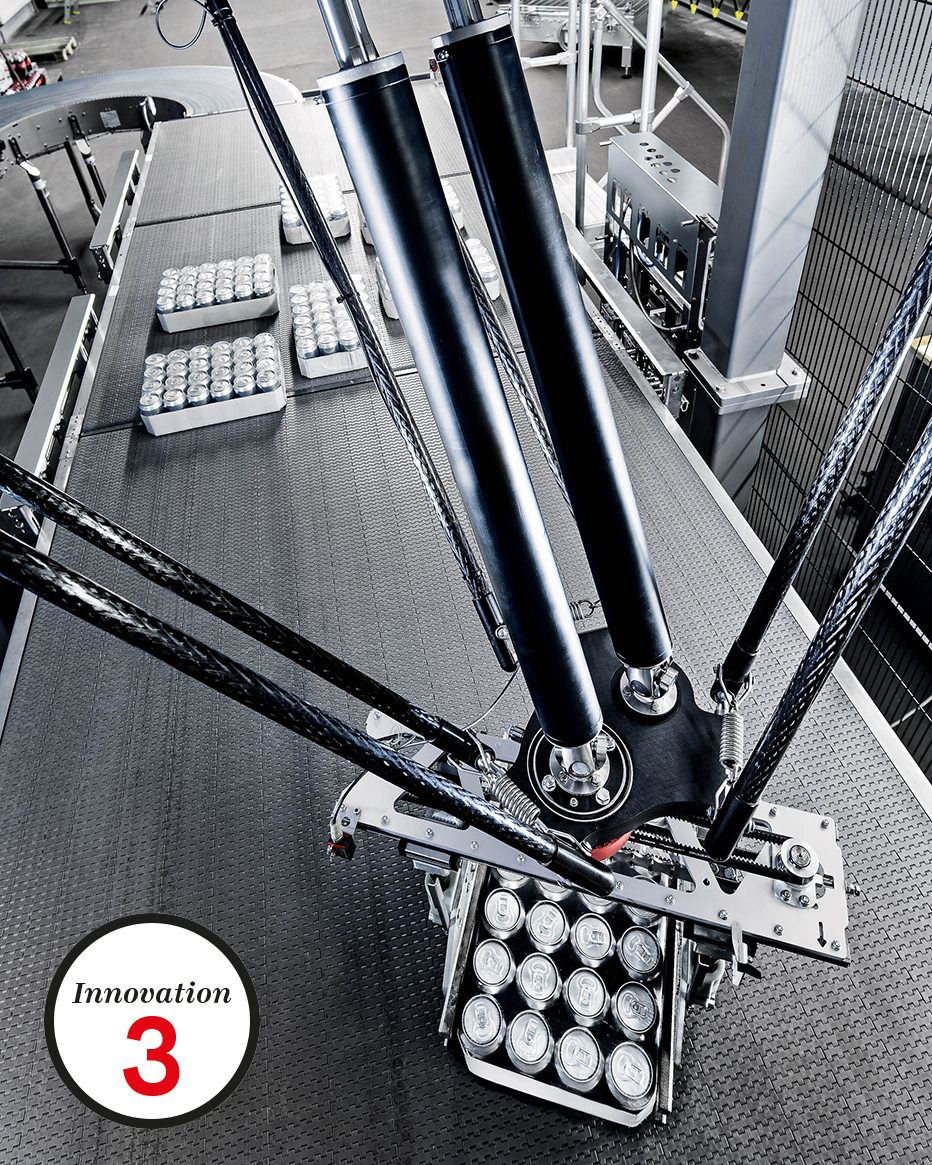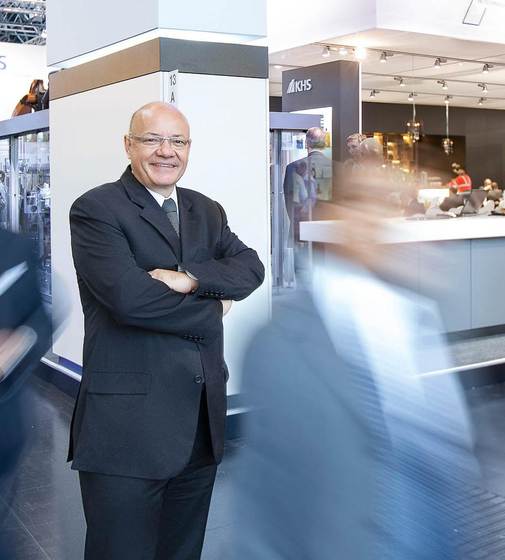Every innovation starts with a goal: to give customers a productive or competitive advantage with a new or further development. This was also the case with the InnoDry Block – the part of the packaging system downstream of the labeler – which KHS is presenting at interpack for the very first time. Compact, blocked systems are becoming increasingly popular with clients. Accordingly, KHS already offers a whole range of equipment in this respect – primarily in conjunction with filling product into PET bottles. “A blocked line results in shorter conveying segments,” explains Hans-Werner Holzer, palletizing product manager for KHS in Worms. “It saves space and as it has fewer elements it requires less maintenance effort and fewer spare parts. Understandably, this is the direction customers want to continue to move in. And as they’ve seen what impact blocking can have at the beginning of a KHS line, they want to have the same at its end.”
Format changeovers without adjustment
This is not so easy, explains Karl-Heinz Klumpe, packaging product manager at KHS in Kleve. “If a customer tells us that they want a certain system, we of course ask which individual effects they wish to achieve with it. In workshops and intensive talks with the customer we then ascertain which concrete demands and requirements he or she has.” In the packaging and palletizing area this is basically simple pack conveying along short segments which require no guides so that no adjustment is necessary during format changeovers. However, when packaging one-way containers two specific aspects must be taken into account. “One special consideration is that despite the envisaged short segments there must be a buffer so that the shrink tunnel can be run empty. This buffer aims to prevent the containers backing up in the tunnel where they would overheat and be damaged or destroyed, in turn making maintenance work on the tunnel necessary and thus preventing a quick restart of the entire packaging line. The other challenge is in the layer formation, namely to permit continuous processing on the palletizer and stability of the packed pallet,” Klumpe states.

Automatic adjustment
In order to meet the first of these two challenges an intelligent buffer system has been integrated into the line which automatically adjusts the conveyor length according to the number of packs between the packaging and palletizing machine. To this end, a U-shaped conveyor segment on two parallel, straight conveying segments moves back and forth depending on how much buffer space is needed. The packs always stay at a defined distance to one another – unlike on normal conveying segments with accumulation rollers where the products can run off over the sides if there is a backup and thus have to be guided by railings. The new system not only makes for an extremely compact design but also prevents longer conveying segments having to be adjusted as is otherwise the case in practice during format changeovers, tying up manual labor and work time and also causing downtimes. “One alternative is automatic railing adjustment,” says Klumpe, “but according to our motto of ‘Less is more’ we wanted to do away with the need for any kind of guides in this section.”
Integrated handle applicator
The flexible buffer is not all, however. “In order to obtain a really short conveying segment for the InnoDry Block all additional handling systems and machines have to be eliminated and integrated into the packaging systems or palletizers,” the packaging line specialist comments. KHS scores with another innovation here; the Carry Strip Master which usually applies a self-adhesive handle to the wrapped pack, has now been integrated into the packaging machine. The handles are now applied off the reel when the film is unraveled before the film is wrapped around the bottle formation. The Carry Strip Master is controlled by the packaging system’s control unit. This makes it unnecessary for the operator to intervene on the conveying segment; full attention can now be turned to the packer and palletizer.
The second task for the packaging and palletizing block without side guides is to accurately grip the packs in the grouping station before they run into the palletizer. Hans-Werner Holzer tells us how this works. “The packs usually exit the packaging machine uniformly across the direction of travel. On the pallet, however, they have to be stacked alternately lengthwise and crosswise from layer to layer in different positions. The effect is like a brick wall: only by combining the packs like this do we have the stability we need to transport pallets safely.” Another important aspect here is that the maximum possible use is made of the space on the pallet.
“A blocked line saves space and requires less maintenance effort and fewer spare parts.”
Highly dynamic handling system
The KHS system now used to sort the packs and bring them into formation no longer needs to back up and distribute the containers at the palletizer infeed as is currently typical. This means that the packs are no longer fed to the palletizer at a fixed access time and point but in a continuous process. Innovative technologies are required so that they continue to be gripped and handled safely and reliably. A camera system detects the position and orientation of the individual packs and passes this information on to the handling system. Even the tiniest angles of rotation in a pack are thus noticed and can be compensated for. “This special laser camera doesn’t provide an image in the conventional sense but records the pack’s contour lines – like a 3D model, if you like,” is how Holzer describes the process. “This information is then sent to the handling system. By comparing this to existing data the system knows what the pack looks like, where it is and if it has an angular offset. This makes it possible to grip packs reliably without them having been previously aligned by guides.” The handling systems have to manipulate the packs highly dynamically while being gentle to the product. Newly developed robots are used for this purpose which synchronize their movements with the speed of the conveying element and shift and turn the packs without a difference in speed. With their low mass and special motion controllers these robots are particularly dynamic – a necessary prerequisite when processing lightweight containers.

Holzer is also so proud of these robots because they have not yet been used in the beverage industry. “This is a very special robot which like the camera system has been specially developed for this machinery,” he enthuses. “This is a good example of how we not only develop innovations like the InnoDry Block in close cooperation with our customers but, as is the case here, also hand in hand with our suppliers – open innovation at its best”, Holzer summarizes. He concludes by stressing that the plant engineering described here is not only gentler to products and more efficient than current systems but also moves one step closer to the ‘operator-free’ production line.
Your contact on this topic
Hans-Werner Holzer
Palletizing product manager
KHS GmbH, Worms, Germany
Phone: +49 6247 973351
Email: hans-werner.holzer@khs.com
Karl-Heinz Klumpe
Packaging product manager
KHS GmbH, Kleve, Germany
Phone: +49 02821 503 212
Email: karl-heinz.klumpe@khs.com























